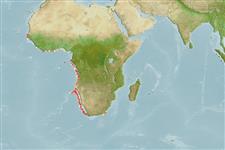分類 / Names
共通名の | 類義語 | Catalog of Fishes(部類, 種) | ITIS | CoL | WoRMS | Cloffa
板鰓亜鋼(サメとエイ類) (sharks and rays) >
Rajiformes (Skates and rays) >
Rajidae (Skates)
Etymology: Rajella: Latin, raja, -ae = a sting ray (Raja sp.) (Ref. 45335).
Environment: milieu / climate zone / depth range / distribution range
生態学
海 深海魚; 深さの範囲 400 - 1640 m (Ref. 106604). Deep-water; 15°N - 34°S
Eastern Atlantic: off southern Rio de Oro in Western Sahara, Namibia, and South Africa. Probably occurs throughout the area along the deeper West African slope.
サイズ / 重さ / 年齢
Maturity: Lm ? range ? - ? cm
Max length : 82.3 cm TL オス/雌雄の選別がない; (Ref. 106604)
簡単な記述
検索表 | 形態学 | 形態計測学
Moderately long snout, small eyes, and a flat disc; tail about as long as body; moderately large, inconspicuous light thorns dorsally and a few on snout; mid-dorsal line of thorns reduced in adolescents and adults (Ref. 5578). Whitish grey to dark grey dorsally, white ventrally with dark rear margins and dark patches on underside of tail (Ref. 5578).
Found in deeper slope waters (Ref. 4426). Feed on cephalopods, mysids and small bony fishes (Ref. 5578). Oviparous (Ref. 50449). Eggs have horn-like projections on the shell (Ref. 205).
Life cycle and mating behavior
Maturities | 繁殖 | Spawnings | Egg(s) | Fecundities | 幼生
Oviparous, paired eggs are laid. Embryos feed solely on yolk (Ref. 50449).
McEachran, J.D. and K.A. Dunn, 1998. Phylogenetic analysis of skates, a morphologically conservative clade of elasmobranchs (Chondrichthyes: Rajidae). Copeia 1998(2):271-290. (Ref. 27314)
Human uses
水産業: 興味がない
用具
特記事項
XMLをダウンロードして下さい
インターネットの情報源
Estimates based on models
Preferred temperature (Ref.
123201): 3.3 - 6.6, mean 4.3 °C (based on 24 cells).
Phylogenetic diversity index (Ref.
82804): PD
50 = 0.5000 [Uniqueness, from 0.5 = low to 2.0 = high].
Bayesian length-weight: a=0.00288 (0.00177 - 0.00470), b=3.29 (3.16 - 3.42), in cm total length, based on LWR estimates for this species & (Sub)family-body (Ref.
93245).
栄養段階 (Ref.
69278): 4.0 ±0.53 se; based on food items.
回復力 (Ref.
120179): 低い, 4.5年~14年の倍増期間の最小個体群 (Fec assumed to be <100).
Fishing Vulnerability (Ref.
59153): Moderate to high vulnerability (53 of 100).
